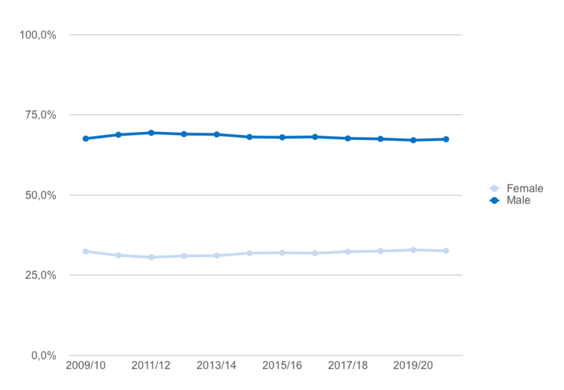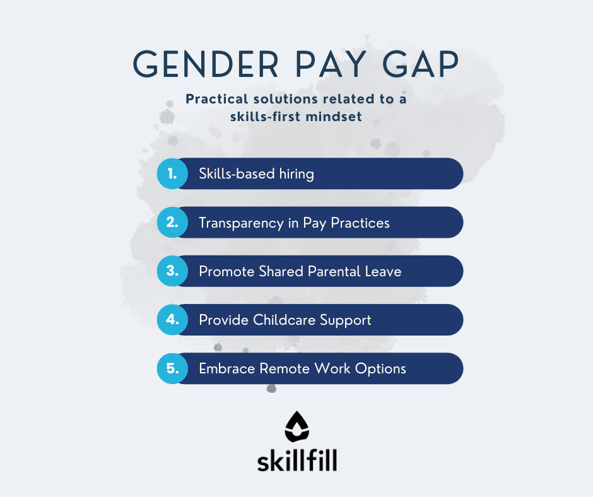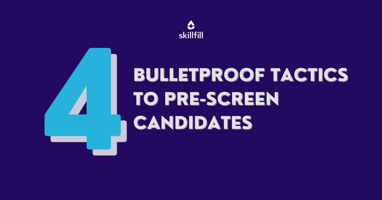The use of AI and tools like ChatGPT is surging, and recruiting is one of the most interesting use...
How skills-based hiring can fix the gender pay gap
According to the Federal Statistical Office (Destatis) the gender pay gap describes the pay gap per hour between women and men. In terms of recent numbers the European Commission data shows that women earn 13% on average less per hour than men.
While the root causes for this difference can be highly complex, fixing the gender pay gap is crucial to achieve a fairer workplace. Not only from an ethical point of view it is a vital task to close the gender pay gap, but also from an economical point of view: Diversity leads to better performing teams.
One of many studies emphasising the benefits of diversity in the workplace is a recent study by BCG. According to this study, diverse teams are 2.2x more likely to be world class innovators and 2.5x more likely to be a fast growing company.
As a company and especially as a recruiter, you might think your practical impact on the gender pay gap is rather small, but you are literally holding one of the keys (if not THE key) to solve this problem.
Find out how you can take action yourself and furthermore, how you can influence other colleagues to support you in fixing the gender pay gap.
Start with your hiring process
Why start with the hiring process? Well, the reasons for the gender pay gap are manifold and obviously the education system amongst others plays a vital role in setting someone’s career path. Having an Engineering background, I quickly checked the numbers from my alma mater RWTH Aachen. And there you go, a university report shows that almost 70% of all students at this (mostly) technical university are male.

From experience I can tell you the most technical courses have a far higher male:female ratio. In fact, less than 15% are female at the Faculty of Mechanical Engineering.
Now if it turns out that technical jobs have a higher salary on average, then this can lead to discrepancies between men and women (salaries are indeed higher for tech roles). Usually these kinds of factors are considered in studies, so that we get an adjusted gender pay gap.
So, yes, there are many factors to be considered and this is just one example, but in this blog post I want to put the focus on what is in your circle of control as a company and as a recruiter. Hiring is the first touch point with a new employee and this is why it’s naturally a starting point for you. So what is it that you can do to solve the problem?
Skills-based hiring becomes the new standard
What is skills-based hiring?
Skills-based hiring is challenging the traditional way of hiring candidates. It is the approach of screening, evaluating, and hiring employees based on their skills, knowledge, and capabilities instead of previous experience, educational background. or demographic profile.
By evaluating candidates only by their ability to perform the job, you are able to ensure you hire the best talent, improve equity in the labour market, and access a wider pool of talent.
Why skills-based hiring is better than CV screening
While CVs hold value and allow you to get a first impression of a candidate, there is a high risk of creating an irreparable bias in the first impression. There are innumerous studies that show that CV screening is highly biased. Harvard Business Review published an article showing that bias in CV screening exists and leads to less positive responses for female candidates as opposed to male candidates.
And as if this is not problematic enough, recent numbers show another issue with CVs: 46% of job seekers are using ChatGPT to brush up their CV.

Successful skills-based hiring in practice
As an example, the Hubble Space Telescope project received 15k applications in a time span of 16 years. When crunching the numbers, it was found that while 23% of the applications came from women, their success rate was only 19%. When deleting personal information from the hiring process and focusing only on the merit of the science, the situation looked different: While men were outperforming women by about 5% before the change in the hiring process, this difference went down to 3% after the name was deleted from a CV. After a full anonymization, women were actually outperforming men by 1%.
Why skills-based hiring is closely linked to the gender pay gap
By using a skills-based approach, you as a company or recruiters in specific can make hiring decisions based on the skills of the candidates, instead of other irrelevant factors such as gender. A skills-based approach plays a crucial role in reducing conscious and unconscious bias in recruitment.
1. Candidates are evaluated based on performance indicators
Using skill assessments, you will evaluate candidates based on their skills and ability to perform the job. By using a standardised measure for all candidates, the risk of using an unconscious double standard when comparing candidates is reduced, which ensures that the most qualified person is selected.
2. Technology helps to remove bias
Technology is here to help, and never to replace the role of the recruiters and hiring managers! The goal is to make processes more efficient by leveraging powerful tech, without taking away the human side when making the hiring decision. Once again, having a neutral tool helping to sort out the different candidates helps to reduce bias and avoids making decisions based on unconscious thoughts such as gender or age.
Important: Make sure that software providers are open about how personal data is used. Algorithms can be biased, too. It is important to understand whether personal information such as gender has an impact on how the algorithms work. My clear recommendation is to avoid working with software that acts as a black box - especially in HR this is crucial(!). Tools like ChatGPT actually carry over potential gender bias as it uses text from the Internet to ´learn´. If it learns from sources that state that ´women are worse in engineering´, it will parrot those completely wrong statements.
3. It promotes diversity and inclusion in the workplace
Instead of using old-fashioned requirements such as previous job titles, or education backgrounds, making the best use of skills lets you tap into a wider pool of talent. From self-taught professionals to diverse profiles who by traditional paths would not send a job application to the position you are hiring for - including women.
By widening the pool of candidates being assessed for a specific position, you are able to tap into different profiles and personalities that will bring diversity to the workforce. A wider pool of candidates together with a hiring process that prioritises skills over backgrounds creates the perfect environment to identify top talent.
How to close the gender pay gap: Developing a skills-first mindset and going beyond skills-based hiring
There is more action you as a company or recruiter can take to solve the gender pay gap. While skills-based hiring is a practical way to improve the hiring process, the underlying mindset is equally important: Thinking ´skills-first´. The following points give you food for thought to rethink some of your processes and if applicable, I mention some tools that I recommend using.

Skills-based hiring
I have described the advantages of skills-based hiring in detail, so just to summarise: Skills-based hiring allows access to a broader talent pool, and helps getting rid of bias in the hiring process. To give you a concrete tool recommendation: With skillfill.ai you can simply upload a job description and it automatically generates the right skill assessment with the most relevant questions to test candidates for their real skill set.
Transparency in pay practices
It is essential to commit to transparency regarding your salaries. Start by conducting an audit of the salaries of both male and female employees, and make the results accessible to all. There is no need to disclose salaries on an individual level, but it’s great to have benchmarks for different roles and seniority levels. If people are underpaid, I would strongly advise to be proactive about it (raising female salaries if they are below the benchmark is actually the quickest way to fix the gender pay gap). Software like Figures can help you benchmark your internal data against external salary numbers. Emphasising transparency not only contributes to closing the gender pay gap but also fosters trust and fairness within your workforce. Employees should be treated fairly and based on their performance.
Promote shared parental leave
Shared parental leave provides an opportunity to address gender imbalances in childcare responsibilities. Encouraging male employees to take advantage of this policy helps to alleviate the burden on their female partners and contributes to closing the gender pay gap. While it is up to politics to support this kind of initiatives, there are great examples such as SAP that go beyond legal standards.
Provide childcare support
Supporting your employees with childcare responsibilities is a key strategy in addressing gender pay disparities. Whether through financial contributions or on-site childcare services, offering assistance can significantly benefit female employees who often bear a greater childcare burden. By easing this burden, your organisation can make a tangible difference in promoting gender pay equality. One great startup solving this problem heynanny.
Embrace remote work options
Flexible working arrangements provide women with the opportunity to balance caregiving responsibilities with their careers, a crucial step in closing the gender pay gap. Additionally, numerous studies have shown that offering flexible work options can enhance employee engagement and productivity. Embracing remote work not only benefits your workforce but also contributes to long-term gender pay equity. Companies like Oyster, lano.io or Deel are very useful when it comes to hiring people abroad. Remote work simply allows you to bring the job to your employee and not vice versa.
Conclusion
Fixing the gender pay gap is a complex topic - hence starting with steps that are in your control is the best way. It is on all of us to close the gender pay gap, at least the adjusted one. People who have the same job and show the same performance should be treated equally. I highly recommend you the Global Gender Gap Report 2023 from the World Economic Forum as a further read to learn more about the gender pay gap.
What's next? Check out how skillfill.ai can help you implement skills-based hiring - click 👇 to get access to our software!
AI-ASSISTED TALENT ASSESSMENT FOR TECH RECRUITERS
Start your 14-day free-trial today!



